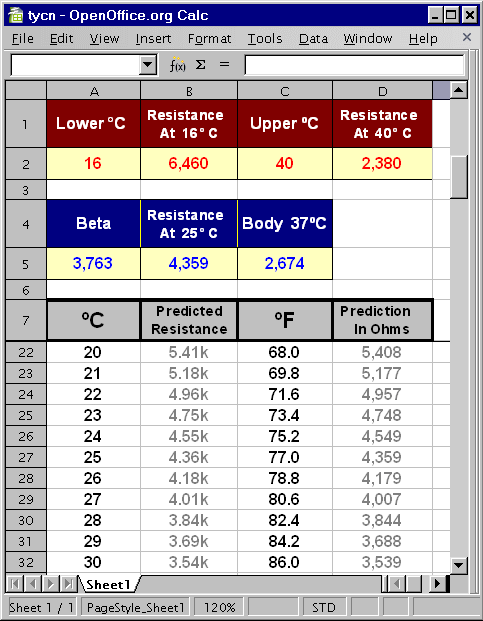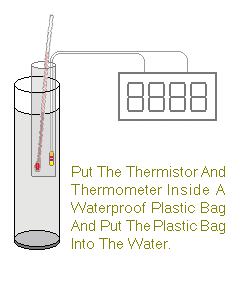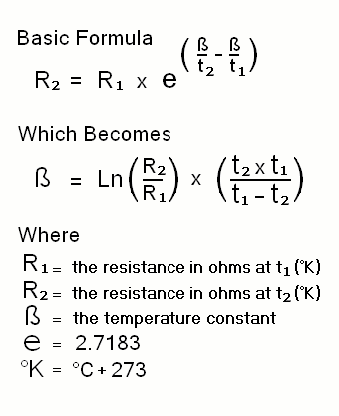You don't need to understand the maths in order to use this spreadsheet to predict the resistance of your thermistor over a range of temperatures.
The resistance of a small bead thermistor varies inversely with its temperature. In other words - as the temperature rises the resistance falls. And as the temperature falls the resistance rises. Consequently - the actual resistance of the thermistor will only coincide with its marked value - at one particular temperature - usually 25°C (77°F).
To calculate the resistance of the thermistor at other temperatures - you need two pieces of information. One is an accurate resistance measurement - taken at a known temperature. And the second is the value of a constant - called Beta. It defines the relationship between changes in temperature and changes in resistance.
Unfortunately - you can't rely on the colour code to provide you with the resistance measurement. Manufacturing tolerances mean that the nominal value of the thermistor can be out by as much as ± 20%.
And - although Beta is described as a constant - its value actually varies from one batch of thermistors to the next. You will find published values for Beta. But these are only typical values - not actual values. And they are only valid for a limited part of the temperature scale. Usually from 25°C (77°F) to 85°C (185°F).
Since the marked value of the thermistor and the figure for Beta are both unreliable - the outcome of any calculations will also be unreliable. In other words - using the published data to predict the value of your thermistor - is a waste of time.
What you really need is reliable data - that's derived directly from your own particular thermistor. That is - two accurate resistance measurements - taken at two different temperatures. The spreadsheet will then use this data to calculate the real value of Beta - and to predict the resistance of your thermistor over a range of temperatures.
The predictions will be at their most accurate - around and between the two temperatures you've chosen. I achieved an accuracy of better than ± 1%. However - the results will only be as good as the quality of your input data. At the bottom of the page - there are a few tips on how to make that data as accurate as possible.
How To Use The Spreadsheet
|

|
|
Making Accurate Readings
The accuracy of the predictions depends acutely on the accuracy of the input data. And the accuracy of the input data - depends on the accuracy of your resistance meter - the accuracy of your thermometer - and the accuracy of your observations.
Because they display a finite number - digital meters create the illusion of accuracy. But the number on the display is really no more than a digital estimate of an analogue input. And - along with the inherent design tolerance of the meter - the final digit of the display is unreliable. To produce it - the meter is likely to be rounding up - or rounding down. For example - a reading of 4.65k could be anywhere between 4645 and 4655 ohms.
The readings will be most accurate when taken at a stable ambient temperature. Place the thermistor and thermometer into a waterproof plastic bag. And immerse the plastic bag in water. Leave the water until it reaches the ambient temperature. That is - until the meter display stops changing. Then take your readings.
A different area - with a different ambient temperature - can then be used to provide the second reading. If you can't find a suitable area - body temperature might provide a reliable alternative.

If you can't find two stable temperatures in your target area of the scale - you'll have to create them artificially. This is less satisfactory - and requires more care and judgement. You'll have to take your readings - while the temperature is changing.
Start with water that's either warm or cold - relative to your target temperature range. Then take your two readings as the water cools down - or as it heats up. You'll have to decide when a particular temperature has been reached - and then take your meter reading.
This is not as accurate as the stable ambient temperature approach. Thermometers and thermistors react to changing temperatures - at different speeds. If the temperature is changing too quickly - a typical glass thermometer will always be playing catch-up with the thermistor.
The temperature must change slowly - so that the thermometer can keep up. If you try to hurry the process along - your measurements will be inaccurate.
Formulas Used In The Spreadsheet

To predict thermistor resistance - the spreadsheet needs an expression for ßeta. This expression is derived from the formula for R2 published in the data sheets. Learn How the formula for R2 becomes a formula for ßeta
OpenOffice Software
Users of Linux are likely to have OpenOffice EasyCalc already. And Windows users can download the free Windows compatible version from WWW.OpenOffice.Org This is a truly comprehensive suite of programmes - and they are all absolutely free. But be warned - it's a big download (130Mb).
 SUGGESTIONS
SUGGESTIONS
 SUGGESTIONS
SUGGESTIONS


